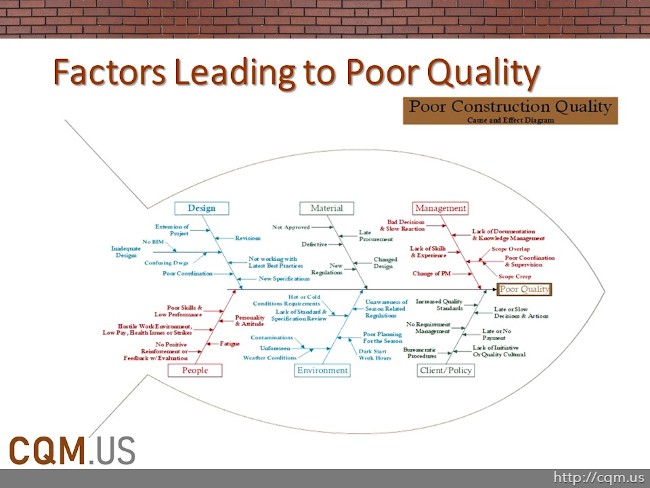CQM Root Causes section is an effort to define Quality in Construction from CQM Methodology perspective and determine the Good vs Bad Quality Root Causes. Many consider Quality Control Inspection as the only task a Quality Manager is to perform and when the test results and inspection reports are not to their liking, they blame the Quality Management Program. CQM Methodology considers a holistic and integrative approach when it comes to the Construction Management Program for Construction-related organizations and projects.

CQM Root Cause Fishbone
As many professional quality experts and project management professionals are familiar with the TQM Tools, Fishbone diagram or Ishikawa diagrams, developed by Kaoru Ishikawa, is the best visual display for causal diagrams. Dr. Hani Emari, PMP has developed a fishbone diagram to detect causes for poor quality in Construction and found that Poor Construction Project Outputs are due to the following factors:
- Poor Design & Engineering
- Poor Specification and/or Late Changes
- Inadequate Design and Poor Design Drawings
- Lack of Best Practices for Preventive measures (BIM)
- Too many Revisions and Poor Coordination
- Confusing Drawings and Irrelevant Information/Details
- Poor Supply of Material
- Submittal not approved properly
- Late Procurement with no advance preparation
- Late requirement Change and Substitution
- Unavailability of specified material or new Regulations
- Defective Material Delivered and not inspected
- Poor Project Management
- Not a Project Management Professional (CQM)
- Change in Project Management Team Personnel
- Bad Decisions made with slow responsiveness
- Poor Coordination and Lack of Supervision & Inspections
- Lack of Documentation and Knowledge Management
- Poor Manpower & People Performance
- Poor Skills, Lack of Training and Low Performance
- Hostile Work Environment, Health Issues, Low Pay, and Strikes
- Communication Barriers due to Personality Types, Cultures, Language and Attitude
- Fatigue and Exhaustion due to overwork
- No positive reinforcement, Feedback, or Evaluation
- Poor Environmental Controls
- Lack of consideration for Hot and Cold weather provisions
- Lack of Checklists for Specification and Standard Reviews
- Unaware of Seasonal Related Regulations and Conditions
- Poor Planning of Seasonal work, dark hours, and wrong season
- Contaminations and Unforeseen Environmental Conditions
- Poor Client Control and Lack of Policy
- Lack of Initiative for an IPD and Quality Culture Mindset
- Lack of Proper Scope and Requirement Management
- Late or No Payment to support the Cash Flow
- Lack of research and development prior to Architect selection
- Irrelevant and Overwhelming Industry Standard Requirements
Poor Specification is the Root Cause of Poor Quality
All the above factors contribute to the Poor Quality of Construction Production, however, the single most important cause that could help prevent almost all of the other factors is the project Specifications.

Project Specifications are the basis for Scope Management and Owner & A/E expectation of the final product. It drives the cost estimate and is the basis for the USACE CQM-C statement “Getting our money’s worth!” and contractors’ rebuttal of “You get what you paid for!” So the more irrelevant details and standard references are made by the A/E, the higher the cost of construction, and the less detail and industry standards are referenced, the fewer quality measures are monitored by the contractor. Therefore, highering the right Architect as the first step is the key to a high-quality construction product. Here are CQM Methodology’s recommendations for the Architects and Engineers:
- Be specific on why a section is provided and avoid irrelevant information and details
- Reference Standards with the reason why they are used, don’t include all possible standards and probable risk factors to transfer all risks which drive Cost unnecessarily high
- Provide Checklists of the most important Quality aspects concerned, whether it is a certain Material defect you are trying to avoid, equipment feature you desire, or environmental factor you are concerned with
- Provide portions of the Standard rather than the entire Standard Number
- Be collaborative and open with the Contractor rather than trying to be sneaky
- The specification is the Manual for what, why, how, when, where a material or activity must be performed, be clear and concise
- Use Specifications as a Communication Tool, don’t rely on others to decrypt your encrypted messages correctly if there is too much noise
